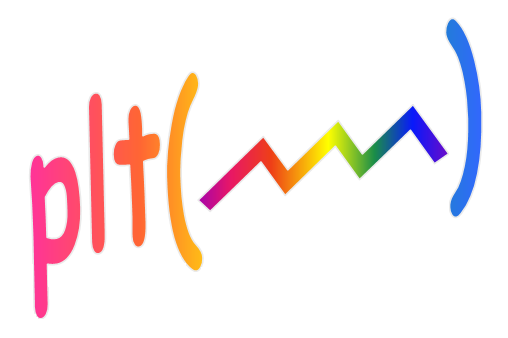Introduction |
plt version 01Jan17 Copyright © 2017, Paul Mennen |
 |
A plotting interface. An alternative to Matlab's plot and plotyy routines
- Like plot, plt commands can be typed at the command prompt to display your workspace arrays. For simple commands the interface is the same.
- Optimized for data exploration.
- Improved zooming, panning, linear/log toggling, & auto-scaling controls.
- You can interactively select which variables to plot (workspace plotting).
- Automatically generates a legend that also provides trace selection controls.
- Up to 999 traces on a single axis. (Limited to 99 traces if a legend is required).
- Fast and easy cursor movement with delta, rms, mean, y/x, and magnitude readouts.
- Support for dual y-axes and sub-plots, each with individual cursor control & readout.
- Peak/Valley finder, display expansion history, and support for metric prefixes.
- Better looking grid lines with selectable color and style.
- Interactive editing of trace properties, figure colors, and annotations.
- Data editing (mouse or keyboard driven).
- Regular updates based suggestions from users.
- A major advantage of plt is the consistency and flexibility of the command line interface,
all explained in a single help file with includes example code for every important option.
You no longer will you have to hunt for the many obscure handle graphics commands used by
the native Matlab commands that are scattered throughout the Matlab documentation.
A GUI building framework. An alternative to Matlab's guide
- Provides a framework for developing graphical user interfaces, usually involving 2D or 3D plotting
- Provides these pseudo objects (collections of Matlab
graphical objects with a single purpose):
- cursor
- grid
- plt
- image
- color picker
- help text
- slider
- popup
- edit object
- Provides these auxiliary functions which perform tasks
commonly needed in plot oriented GUIs:
- pltt
- prin
- datestr
- metricp
- figpos
- pltwater
- Pvbar
- Pebar
- Pquiv
- The capability to move and resize the pseudo objects and native Matlab objects while recording the positions so that they can be made permanent.
- A methodology for combining these elements presented with a series of examples & demo programs. These examples are designed to demonstrate the use of the various pseudo objects.
Signal Processing. Fourteen of the example programs, in addition to their role in demonstrating various plt features, were also designed to have an educational value in the signal processing field:
▪ bounce.m (random walks) ▪ curves.m (classic plane curves) ▪ dice.m (Monte Carlo simulation) ▪ editz.m (z-plane analysis) ▪ gauss.m (summation of random variables) ▪ gui2.m (classical analog filters) ▪ julia.m (Mandelbrot & Julia set fractals) ▪ pltquiv.m (Hermite polynomial interpolation) ▪ pltmap.m (2-dimensional cubic interpolation) ▪ square.m (synthesis of harmonic functions) ▪ tas.m (aircraft performance modeling) ▪ weight.m (classic sound level weighting curves) ▪ wfall.m (clipping distortion effects) ▪ winplt.m (fft windowing)
This toolbox has been extensively tested and verified to run under all Matlab releases from 12.1 (ver 6.1) to R2016a under Windows 10, Windows 8, Windows 7, Windows Vista, and Windows XP. Brief testing has also been done under the Mac and other Unix based platforms.
I hope using plt enhances your Matlab experience.
I'm interested in hearing about your problems and suggestions.
You can reach me at [email protected].